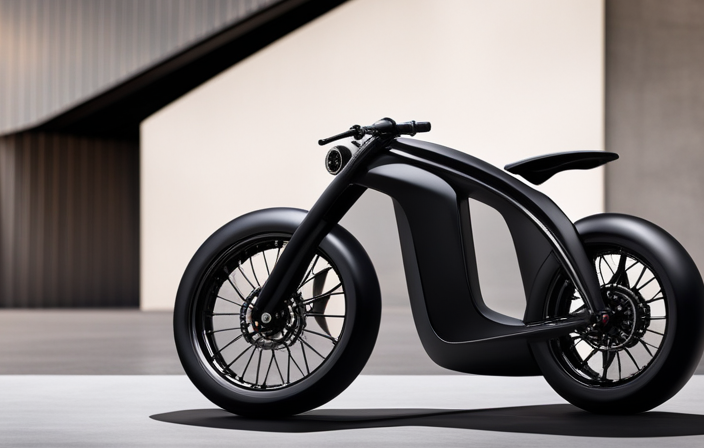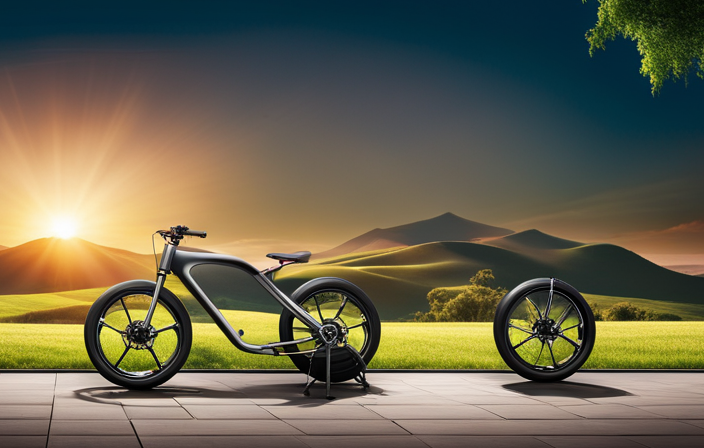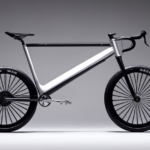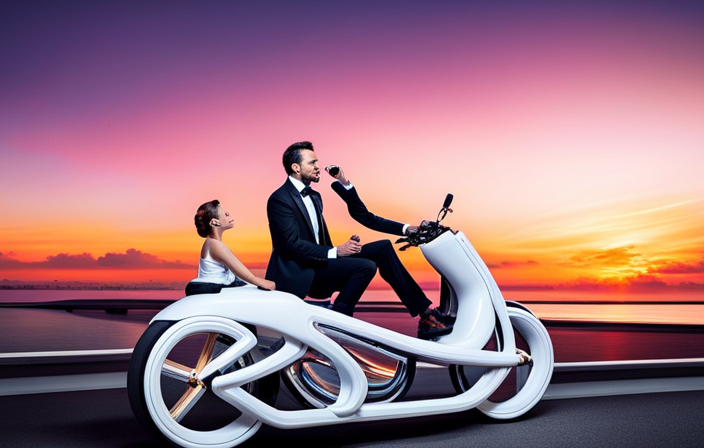As someone who is passionate about cycling and has a keen interest in electric bicycles, I’ve consistently been intrigued by how much these cutting-edge devices weigh.
Imagine cruising effortlessly down the road, feeling the wind in your hair, and knowing that your trusty electric bike is supporting you every step of the way.
But just how much does an electric bike weigh?
In this article, we’ll explore the factors that affect electric bike weight, the average weight range, and why finding the right balance is crucial for your cycling experience.
So let’s dive in and uncover the secrets behind the weight of electric bikes.
Key Takeaways
- Lightweight materials like carbon fiber reduce weight and increase agility.
- Electric bikes usually weigh between 40 to 70 pounds (18 to 32 kilograms), with weight varying based on factors such as battery type, frame material, motor size, and accessories.
- Choosing a lighter electric bike enhances the riding experience by offering easier maneuverability, longer battery life, and improved range.
- Heavy-duty electric bikes are designed for off-road and mountain biking adventures, with features like enhanced stability, durability, and larger, more powerful batteries for longer rides.
Factors Affecting Electric Bike Weight
Want to know what factors can affect the weight of an electric bike?
Well, there are several weight reduction techniques that manufacturers employ to make electric bikes lighter. One such technique is using lightweight materials like carbon fiber for the frame and components. This not only reduces the overall weight but also increases the bike’s agility and maneuverability.
Additionally, the type and capacity of the battery used in an electric bike can greatly impact its weight. High-capacity batteries tend to be heavier, but they also offer a longer range. It’s important to strike a balance between battery capacity and weight to ensure optimal performance.
Now that we’ve discussed the factors affecting electric bike weight, let’s move on to the average weight range of these bikes.
Average Weight Range of Electric Bikes
Looking for information on electric bikes? Wondering about the typical weight range? When it comes to electric bikes, their weight can vary depending on several factors. These factors include the type of battery used, the frame material, the motor size, and any additional features or accessories. On average, electric bikes usually weigh between 40 to 70 pounds (18 to 32 kilograms). However, it’s important to note that there are electric bikes that can weigh less or more than this range. Factors affecting electric bike weight can also include the type of terrain you plan to ride on and your own body weight. Lighter electric bikes have several benefits, including easier maneuverability, improved battery efficiency, and increased range. Now, let’s move on to choosing the right electric bike for your needs and preferences.
Choosing the Right Electric Bike for Your Needs
If you’re in the market for an electric bike, it’s crucial to choose the right one that suits your specific needs and preferences. One important factor to consider is the weight of the electric bike. Lightweight frame materials, such as aluminum or carbon fiber, are commonly used to reduce the overall weight of electric bikes. These materials provide strength and durability while keeping the bike light and easy to maneuver.
There are several benefits to opting for a lighter electric bike. Firstly, it makes it easier to pedal and handle, especially when navigating through tight spaces or uphill. Secondly, a lighter electric bike can have a longer battery life, allowing for extended rides without needing to recharge. Lastly, transporting a lighter electric bike is much more convenient, whether it’s loading it onto a car rack or carrying it upstairs.
Considering these factors, choosing a lighter electric bike can greatly enhance your riding experience.
Moving on to the next section, let’s explore the benefits of lighter electric bikes.
Benefits of Lighter Electric Bikes
When you ride a lighter electric bike, you’ll feel as if you’re effortlessly gliding through the streets, with the bike responding quickly and smoothly to your every move.
Lighter electric bikes are made possible by the use of lightweight frame materials such as carbon fiber or aluminum alloys. These materials not only reduce the overall weight of the bike but also provide durability and strength.
The lighter weight of the bike has a direct impact on battery efficiency, allowing for longer rides and increased range. Additionally, a lighter electric bike is easier to maneuver, making it ideal for urban commuting or navigating through crowded streets.
Considering these benefits, it’s clear that a lighter electric bike offers a superior riding experience.
Now let’s explore the considerations for heavy-duty electric bikes.
Considerations for Heavy-duty Electric Bikes
When it comes to heavy-duty electric bikes, there are a few key considerations to keep in mind.
First and foremost, these bikes are designed for enhanced stability and durability, making them perfect for off-road and mountain biking adventures.
Additionally, heavy-duty electric bikes often come equipped with larger, more powerful batteries. This means you can enjoy longer rides without worrying about running out of juice.
Enhanced stability and durability
The enhanced stability and durability of electric bikes make them a reliable option for any adventure, built to withstand the test of time.
One key factor that contributes to this stability and durability is the careful weight distribution of electric bikes. The weight of the battery and motor is typically positioned low and centered on the frame, which helps to improve balance and handling. This optimal weight distribution also has a positive impact on the bike’s performance, allowing for better maneuverability and control.
Additionally, electric bikes are constructed with high-quality materials and components that are designed to withstand the rigors of off-road and mountain biking. From reinforced frames to durable tires, these bikes are built to handle rough terrain and challenging conditions.
This makes electric bikes suitable for off-road and mountain biking adventures, providing a smooth and reliable ride.
Suitable for off-road and mountain biking
With their enhanced stability and durability, electric bikes prove to be an ideal choice for off-road and mountain biking adventures, providing a reliable and smooth ride. Off-road electric bike features make them suitable for tackling challenging terrains with ease.
When choosing the right mountain electric bike, consider features such as robust suspension systems, wide and grippy tires, and powerful motors that offer excellent torque for climbing steep hills. Additionally, look for bikes with strong frames and reliable braking systems to ensure safety during descents. The ability to adjust the level of assistance provided by the electric motor is also crucial for maintaining control on different types of trails. These features combine to create a thrilling and exhilarating off-road biking experience like no other.
Transitioning to the next section, longer battery life is essential for extended rides, allowing riders to explore more remote and exciting trails.
Longer battery life for extended rides
For those seeking epic adventures on their off-road excursions, having a longer battery life on their e-bikes becomes a game-changer. It allows them to explore remote and exciting trails without worrying about running out of power.
One important aspect to consider when it comes to battery life is proper battery maintenance. Regularly checking the battery’s charge level, avoiding extreme temperatures, and following the manufacturer’s guidelines for charging can help prolong its lifespan.
Additionally, it’s worth noting that a longer battery life can also have an impact on bike handling. The extra weight of a larger battery can affect the bike’s balance and maneuverability, especially when tackling challenging terrains.
Finding the right balance between battery capacity and bike handling is crucial for riders who want to enjoy extended rides without compromising on performance.
Speaking of performance, let’s now delve into the importance of weight distribution for e-bikes.
Importance of Weight Distribution
When it comes to heavy-duty electric bikes, weight distribution plays a crucial role in ensuring better handling. A well-balanced weight distribution allows for smoother maneuverability and more control over the bike, especially in challenging terrains.
Additionally, the weight distribution of an electric bike can greatly impact its overall performance, including factors like acceleration, stability, and braking.
Lastly, it is worth noting that the weight distribution of an electric bike also affects its battery efficiency and range. A poorly distributed weight can put more strain on the battery, leading to reduced efficiency and shorter range between charges.
Balanced weight for better handling
The balanced weight of an electric bike is like a feather on wheels, making handling a breeze. When it comes to electric bikes, weight distribution plays a crucial role in determining overall performance.
Having a balanced weight ensures that the bike remains stable and easy to control, especially during turns and maneuvers. It allows for better handling and maneuverability, providing a smooth and enjoyable riding experience. A well-distributed weight also minimizes the risk of tipping over or losing control, enhancing safety for the rider.
Moreover, a balanced weight distribution impacts the bike’s overall performance, including acceleration, braking, and efficiency. It enables the bike to accelerate faster, brake more effectively, and conserve energy efficiently.
Therefore, maintaining a balanced weight on an electric bike is essential for optimal performance and a superior riding experience, impacting various aspects of its overall performance.
Impact on overall bike performance
When it comes to electric bikes, balanced weight is crucial for better handling. However, weight distribution doesn’t just affect the bike’s maneuverability; it also has a significant impact on its overall performance.
The average weight range of an electric bike can vary depending on factors such as the size of the battery and frame material, but typically, they weigh between 40 to 70 pounds. Proper weight distribution ensures that the bike remains stable and easy to control, especially when navigating corners or uneven terrain.
Additionally, a well-balanced electric bike can provide a smoother and more comfortable ride, reducing strain on the rider’s body. Understanding the importance of weight distribution is essential for maximizing the performance and enjoyment of an electric bike.
Next, we’ll explore the effects of weight distribution on battery efficiency and range.
Effects on battery efficiency and range
Optimizing weight distribution significantly impacts battery efficiency and range on an electric bicycle. When it comes to battery charging techniques, a lighter electric bike requires less energy to charge, resulting in improved battery efficiency. Additionally, a lighter bike can travel longer distances on a single charge, thanks to reduced energy consumption. Terrain also plays a crucial role in battery efficiency. Uphill rides demand more power from the battery, whereas downhill rides allow for energy recovery through regenerative braking. Therefore, the weight of the electric bike affects its performance on different terrains, influencing the battery’s efficiency and range. To illustrate this, consider the following table:
| Terrain Type | Battery Efficiency | Range Improvement |
|---|---|---|
| Uphill | Decreased | Reduced |
| Downhill | Increased | Extended |
| Flat | Optimal | Unchanged |
Understanding the impact of weight on battery efficiency and range is essential for designing effective weight reduction strategies for electric bikes. Transitioning into the subsequent section, let’s explore these strategies to enhance electric bike performance.
Weight Reduction Strategies for Electric Bikes
When it comes to reducing the weight of electric bikes, there are several key strategies that can be employed.
Firstly, opting for lightweight frame materials, such as carbon fiber or aluminum, can significantly decrease the overall weight of the bike.
Secondly, choosing a smaller battery size, if possible, can also help to reduce weight without sacrificing too much range.
Additionally, considering a hub motor instead of a mid-drive motor can be a weight-saving option, as hub motors are typically lighter.
Lastly, limiting the number of additional accessories on the bike can help to trim down unnecessary weight.
Opt for lightweight frame materials
Choose a lightweight frame material for your electric bike, like carbon fiber. Carbon fiber can reduce the weight by up to 30% compared to traditional steel frames.
Lightweight frame materials have numerous benefits for electric bikes. Firstly, they make the bike easier to handle and maneuver, especially when going uphill or navigating tight spaces.
Secondly, a lighter electric bike requires less effort to pedal, allowing riders to travel longer distances without getting tired quickly. Additionally, a lighter frame means better acceleration and improved overall performance.
Carbon fiber is an excellent choice as it is not only lightweight but also strong and durable. By opting for a lightweight frame material, you can enhance your electric bike’s performance and enjoy a more enjoyable riding experience.
Speaking of making further weight reductions, another option to consider is choosing a smaller battery size if possible.
Choose a smaller battery size if possible
If you’re looking to maximize your electric bike’s performance and enhance your riding experience, consider going for a smaller battery size, if possible. While a larger battery may provide longer range, opting for a smaller battery size has its advantages.
Here are three reasons to consider a smaller battery size for your electric bike:
-
Weight reduction: A smaller battery means less weight on your electric bike. This can make it easier to handle and maneuver, especially if you need to carry or transport your bike frequently.
-
Improved agility: With a smaller battery, your electric bike will have a lower center of gravity. This results in improved stability and maneuverability, allowing you to navigate tight corners and obstacles with ease.
-
Cost savings: Smaller batteries are generally more affordable compared to larger ones. Choosing a smaller battery size can help you save money upfront, making it a budget-friendly option.
Considering these pros and cons of battery size comparison, you can now make an informed decision about the most suitable battery size for your electric bike. When considering other aspects of your electric bike, such as the motor, it’s important to weigh the options and choose what best suits your needs.
Consider a hub motor instead of a mid-drive motor
Opt for a hub motor instead of a mid-drive motor and feel the exhilarating power and smooth acceleration as you effortlessly glide through the streets.
Hub motors have several advantages over mid-drive motors. Firstly, they are much quieter, making your ride more enjoyable and peaceful. Additionally, hub motors are easier to maintain as they have fewer moving parts. This means less time and money spent on repairs and maintenance.
Another advantage of hub motors is their simplicity, making them more reliable and durable in the long run. When comparing hub motors to mid-drive motors, hub motors offer a more direct drive system, resulting in a smoother and more efficient power delivery.
So, if you want a bike that offers a powerful and seamless riding experience, a hub motor is the way to go.
Now, let’s discuss how to limit the number of additional accessories.
Limit the number of additional accessories
Minimize the multitude of miscellaneous accessories to maintain a minimalist and streamlined electric ride. When it comes to an electric bike, weight distribution plays a crucial role in its overall performance. Adding too many additional accessories can negatively impact the weight distribution, making the bike less balanced and potentially affecting its handling on the road.
Moreover, the added weight can also have an impact on battery efficiency, as the motor needs to work harder to propel a heavier bike. By limiting the number of extra accessories, you can ensure a more even weight distribution and improve the overall efficiency of your electric bike.
Now, let’s move on to some tips for maneuvering heavier electric bikes, which can help you handle the additional weight with ease.
Tips for Maneuvering Heavier Electric Bikes
To handle heavier electric bikes, you’ll need to master some maneuvering techniques. Here are three tips to make maneuvering your electric bike easier:
-
Shift your weight: When turning or cornering, shift your body weight towards the inside of the turn. This helps to maintain balance and stability, especially when dealing with a heavier bike.
-
Use your brakes wisely: Proper braking technique is crucial when maneuvering a heavy electric bike. Gradually apply the brakes to avoid sudden stops or skidding, which can be dangerous. Also, remember to distribute your weight evenly while braking to maintain control.
-
Practice slow-speed maneuvers: Slow-speed maneuvers, such as U-turns and tight turns, can be challenging with a heavier electric bike. Take your time and practice these maneuvers in a safe area to improve your control and balance.
Mastering these maneuvering techniques will not only make riding a heavier electric bike easier but also enhance the overall riding experience.
Speaking of enhancing your riding experience, proper maintenance is essential to ensure your electric bike stays in top condition.
The Importance of Proper Maintenance
When it comes to maintaining my electric bike, there are several key points that I always keep in mind.
First and foremost, I regularly check and maintain the tire pressure to ensure optimal performance and prevent any potential punctures.
Additionally, I make it a point to keep the chain clean and lubricated, as this not only enhances the bike’s efficiency but also extends the lifespan of the components.
Lastly, I always monitor the battery health and charging habits, as well as inspect and tighten all bolts and screws to ensure a safe and smooth ride.
Regularly check and maintain tire pressure
Make sure you always check and maintain your tire pressure regularly on your electric bike. Proper tire pressure is crucial for weight management and overall performance of your bike.
When the tires are properly inflated, you’ll experience better traction, control, and efficiency. Low tire pressure can lead to increased rolling resistance, making it harder to pedal and decreasing your overall range. On the other hand, overinflated tires can cause a harsh ride and reduce the bike’s ability to absorb bumps and vibrations.
To maintain the optimal tire pressure, use a pressure gauge and refer to the manufacturer’s recommendations. Inspect the tires for any signs of wear or damage and replace them if necessary. Keeping your tires properly inflated will not only enhance your riding experience but also extend the lifespan of your electric bike.
Speaking of maintenance, another crucial step is to keep the chain clean and lubricated, ensuring smooth and efficient pedaling.
Keep the chain clean and lubricated
Ensuring your chain is clean and well-lubricated guarantees a smooth and pleasurable riding experience. Weight maintenance is crucial when it comes to electric bikes, and the chain plays a significant role in this aspect.
A clean and lubricated chain reduces friction and wear, ultimately improving the efficiency of the bike. Regularly cleaning the chain with a degreaser and a brush helps remove dirt and grime that can accumulate over time. Once clean, applying a quality bicycle chain lubricant ensures smooth movement and prevents rust.
This simple maintenance task not only extends the lifespan of your chain but also enhances your overall riding performance.
Moving on to the next topic of monitoring battery health and charging habits, it is important to keep your electric bike in optimal condition for a long-lasting battery life.
Monitor battery health and charging habits
To ensure optimal battery health and prolong its lifespan, it’s important for you to monitor your charging habits and regularly check the battery’s condition.
Maintaining battery charging efficiency is crucial for an electric bike’s performance. Charging too frequently or not enough can have a significant impact on the battery’s lifespan. Overcharging can cause excessive heat, leading to battery degradation, while undercharging can result in decreased battery capacity over time.
It’s recommended to avoid charging the battery to 100% all the time and instead aim for a range between 20% and 80%. Additionally, it’s important to avoid leaving the battery fully discharged for extended periods.
By being mindful of your charging habits and ensuring the battery’s health, you can maximize the lifespan and performance of your electric bike.
Moving on to the next section about inspecting and tightening all bolts and screws…
Inspect and tighten all bolts and screws
Check all the bolts and screws on your electric bike regularly to make sure they are securely tightened. This is crucial for maintaining the overall integrity and safety of your bike.
Not only can loose bolts and screws affect the performance of your electric bike, but they can also have a significant impact on weight distribution and bike handling. When bolts and screws are loose, it can throw off the balance of the bike, making it more difficult to control and maneuver.
To ensure optimal performance, inspect all areas of your bike where bolts and screws are present, such as the frame, handlebars, seat, and pedals. Tighten any that are loose using the appropriate tools.
By keeping all bolts and screws tight, you can enjoy a smoother and safer ride.
In the future of electric bike technology, advancements are being made to enhance weight distribution and improve bike handling even further.
The Future of Electric Bike Technology
Advancements in battery technology, lightweight frame designs, and the integration of smart features and connectivity are revolutionizing the future of electric bike technology.
The development of more efficient batteries means longer ride times and faster charging capabilities. Lightweight frames make electric bikes easier to handle and transport, while smart features like GPS navigation and smartphone connectivity enhance the overall riding experience.
These advancements are paving the way for a new era of electric bikes that are more versatile, user-friendly, and technologically advanced.
Advancements in battery technology
With advancements in battery technology, electric bikes have become lighter and more efficient, making them a popular choice for eco-conscious commuters. These advancements in battery technology have been driven by the development of smart battery technology and the improvement of charging infrastructure.
Here are four key advancements in battery technology that have contributed to the weight reduction and increased efficiency of electric bikes:
-
Lithium-ion batteries: These lightweight and high-capacity batteries are now commonly used in electric bikes, providing a longer range and faster charging times.
-
Battery management systems: These intelligent systems optimize the performance and lifespan of the battery, ensuring maximum efficiency and reliability.
-
Regenerative braking: This technology allows the electric bike to recharge the battery while braking or going downhill, increasing the overall efficiency and range.
-
Swappable batteries: Some electric bikes now offer swappable battery packs, allowing riders to easily replace a depleted battery with a fully charged one, eliminating the need for lengthy recharging times.
With these advancements in battery technology, electric bikes have become more practical and convenient. This, coupled with lightweight frame designs, has made electric bikes an increasingly attractive option for commuters seeking a greener and more efficient mode of transportation.
Lightweight frame designs
Imagine gliding effortlessly through the city streets on a sleek and nimble ride, thanks to the use of lightweight frame designs in modern electric bikes. Manufacturers have been implementing various weight reduction strategies to create electric bikes that are easier to handle and maneuver. By using materials such as carbon fiber and aluminum alloys, these lightweight frames not only make the bike easier to carry and transport, but also have a positive impact on overall performance.
The reduced weight allows for better acceleration, improved battery efficiency, and increased range. Additionally, the lighter frame design enhances the bike’s agility and responsiveness, making it more enjoyable to ride in urban environments. With advancements in lightweight frame technology, electric bikes are becoming a practical and efficient mode of transportation.
Transitioning into the next section, let’s explore the integration of smart features and connectivity in these innovative rides.
Integration of smart features and connectivity
Get ready to experience a whole new level of convenience and excitement as you connect seamlessly with your electric ride through the integration of smart features.
Smart connectivity is revolutionizing the way we interact with electric bikes. It allows riders to control and monitor their bike’s performance and settings with just a few taps on their smartphone.
However, integrating these smart features into electric bikes does come with its challenges. Manufacturers must ensure compatibility between different devices and platforms, maintain a secure and stable connection, and optimize power consumption. These hurdles can be difficult to overcome.
Despite these challenges, the benefits of smart connectivity are undeniable. It offers riders a personalized and intuitive riding experience.
Now, let’s address some common misconceptions about electric bike weight.
Common Misconceptions About Electric Bike Weight
Contrary to popular belief, electric bikes are not as heavy as a ton of bricks. Weight misconceptions surrounding electric bikes can often lead to misunderstandings about their performance. Here are three important points to consider:
-
Weight distribution: Electric bikes are designed with a balanced weight distribution, ensuring a comfortable and stable riding experience. The battery and motor are strategically placed to maintain optimal performance.
-
Technology advancements: With advancements in materials and technology, electric bike manufacturers have been able to reduce the weight of these bikes significantly. Lightweight frames and components make them easier to handle and maneuver.
-
Impact on performance: While electric bikes may weigh more than traditional bicycles, the additional weight is hardly noticeable during rides. The motor assistance offsets the weight and allows for efficient pedaling, making it easier to tackle hills and longer distances.
Understanding these weight misconceptions and their impact on performance can help you make an informed decision when choosing an electric bike. In the next section, we will explore real-life examples of electric bike weight without missing a beat.
Real-life Examples of Electric Bike Weight
When it comes to electric bikes, there are popular lightweight models that are designed for everyday commuting and recreational use. These bikes are built with lightweight materials such as aluminum or carbon fiber, making them easy to maneuver and transport.
On the other hand, there are heavy-duty electric bikes that are specifically designed for specific purposes such as off-roading or cargo hauling. These bikes are built with sturdy frames and components to handle the extra weight and provide a smooth and stable ride.
Popular lightweight electric bike models
Imagine effortlessly gliding through the streets on one of the popular lightweight electric bike models available, feeling the lightness and freedom as you ride. When it comes to electric bikes, weight plays a crucial role in determining both speed and range.
That’s why many manufacturers have focused on creating the lightest electric bike models possible. These bikes are designed with lightweight materials such as carbon fiber frames and aluminum components, resulting in a significantly reduced weight compared to traditional electric bikes. The advantage of these lightweight models is that they offer improved speed and increased range due to their reduced weight.
With these bikes, you can zip through traffic and cover long distances without worrying about running out of battery power.
Now, let’s transition into the next section where we’ll explore heavy-duty electric bikes for specific purposes.
Heavy-duty electric bikes for specific purposes
Transitioning to heavy-duty electric bikes for specific purposes, these robust models cater to the needs of adventurers, commuters, and off-road enthusiasts alike.
Heavy-duty electric bikes are designed with features that make them ideal for tackling challenging terrains and carrying heavier loads. These bikes often have reinforced frames and larger motors, allowing them to handle rough trails and steep inclines with ease. Additionally, they are equipped with high-capacity batteries that provide extended range and power.
The benefits of heavy-duty electric bikes extend beyond their ruggedness. They offer enhanced stability and control, making them suitable for long-distance rides and carrying cargo. Whether you’re embarking on a thrilling mountain biking adventure or need a reliable mode of transportation for your daily commute, heavy-duty electric bikes are built to deliver.
Moving forward, personal stories and experiences with electric bike weight will be explored.
Personal Stories and Experiences with Electric Bike Weight
I’ve been an electric bike owner for several years now, and I can attest to the importance of managing the weight of these bikes.
One of the things that I have found most helpful is reading testimonials from other electric bike owners who have shared their experiences with managing weight. These personal stories have provided me with valuable insights and tips on how to effectively handle the weight of my own electric bike.
Additionally, I have learned various tricks and techniques for managing the weight. For example, using panniers or baskets to distribute the load evenly can be really helpful. Another technique I’ve found useful is adjusting the tire pressure to improve the bike’s handling.
Overall, by learning from others and experimenting with different strategies, I have been able to effectively manage the weight of my electric bike and enjoy a smoother riding experience.
Testimonials from electric bike owners
Many electric bike owners have shared their positive experiences and rave about the weight of their bikes.
Personally, I have found that owning an electric bike has been a game-changer in terms of the weight reduction strategies I can implement. The lightweight design of my electric bike allows for easy maneuverability and effortless transportation.
Whether I need to carry it up a flight of stairs or load it into my car, the weight is never an issue. Additionally, the reduced weight of my electric bike has made it more enjoyable to ride, as it feels agile and responsive on the road.
With these benefits in mind, I have discovered some tips and tricks for managing electric bike weight that I will share in the next section.
Tips and tricks for managing electric bike weight
To effectively manage the weight of your electric bike, here are some handy tips and tricks:
-
Optimize battery life: One way to reduce weight is by managing your battery usage efficiently. Avoid unnecessary acceleration and use pedal-assist mode when possible to extend battery life.
-
Choose lightweight accessories: Consider swapping heavy accessories for lighter alternatives. For example, you can replace a bulky lock with a lightweight and secure folding lock.
-
Streamline your cargo: Carry only the essentials to reduce the overall weight of your bike. Invest in lightweight panniers or baskets for storage, and regularly declutter to eliminate unnecessary items.
-
Regular maintenance: Keep your electric bike in top shape by regularly maintaining it. Lubricate the chain, keep tires properly inflated, and ensure all components are functioning optimally. This will help reduce any additional weight caused by friction or inefficiencies.
By following these tips, you can effectively manage the weight of your electric bike and enjoy a smoother and more efficient ride.
Now let’s explore some FAQs about electric bike weight.
FAQs About Electric Bike Weight
Curious about the weight of electric bikes? Well, you’ll be surprised to know that these lightweight wonders can still pack a punch!
One of the advantages of lightweight electric bikes is their agility. With less weight to carry, they are easier to maneuver and handle, making them perfect for navigating through traffic or tight spaces.
Additionally, the weight of an electric bike can have an impact on its speed and range. Lighter bikes tend to have better acceleration and can reach higher speeds, while heavier bikes may sacrifice some speed for increased range.
Finding the right balance between weight, speed, and range is crucial when choosing an electric bike that suits your needs.
In the next section, we will explore how to strike this balance and find the perfect electric bike for you.
Conclusion: Finding the Right Balance
Ready to find the perfect electric bike that strikes the right balance between weight, speed, and range? When it comes to electric bikes, finding the right balance is crucial.
Weight distribution plays a significant role in the overall performance and handling of the bike. A well-balanced electric bike will not only be easier to maneuver but also provide a more comfortable and stable ride.
It’s important to consider the weight distribution when choosing an electric bike. Look for a bike that has a low center of gravity, with the battery and motor positioned in a way that evenly distributes the weight. This will ensure better stability and control, especially when navigating corners or uneven terrain.
So, take your time to research and test different models to find the perfect electric bike that offers a well-balanced weight distribution for an enjoyable riding experience.
Frequently Asked Questions
Can I use an electric bike for commuting long distances?
Yes, you can use an electric bike for commuting long distances. The electric bike’s battery life allows for extended rides, and there are charging stations available along the way to ensure you can recharge when needed.
Are electric bikes suitable for off-road adventures?
Electric bikes are a great option for off-road adventures. They handle well on challenging terrains and have impressive battery life. With their power and versatility, they make every off-road journey exhilarating and unforgettable.
How much weight can an electric bike carry?
An electric bike’s cargo capacity and weight limit can vary depending on the model. It is important to check the manufacturer’s specifications, as some electric bikes can carry up to 300 pounds of weight.
Can I ride an electric bike in the rain?
Yes, you can ride an electric bike in the rain. However, it’s important to take some maintenance precautions. Keep your bike clean and dry, lubricate the chain regularly, and consider adding fenders to protect yourself from splashes. Riding in the snow requires special tires.
Are electric bikes more expensive than regular bicycles?
Yes, electric bikes are generally more expensive than regular bicycles. However, when considering the affordability of electric bikes, it’s important to compare the long-term cost savings in terms of fuel and maintenance expenses.
Conclusion
So there you have it, my friend! After delving into the world of electric bike weight, we’ve uncovered some fascinating insights.
From the factors that affect their weight to the average range we can expect, it’s clear that finding the right balance is key.
Whether you’re in the market for a lighter model for zipping around town or a heavy-duty beast for off-road adventures, there’s an electric bike out there for you.
So hop on, embrace the weight, and let the euphoric journey begin!
















